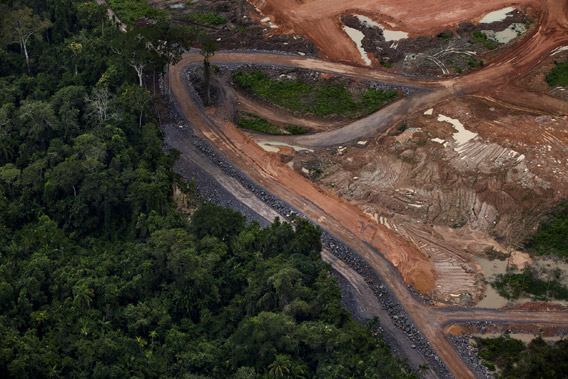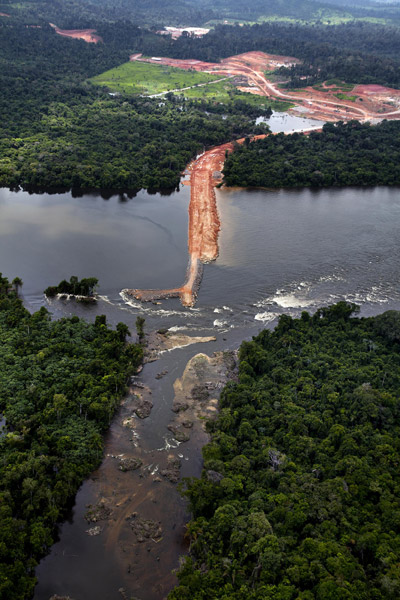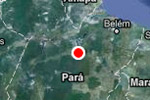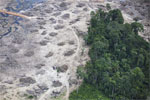| Brazil’s Supreme Court overruled the Federal Appeals Court’s decision on August 28, 2012. Construction resumed the same day. |

Construction site of the Belo Monte Dam and hydropower project, near Altamira. Photo by © Greenpeace/Marizilda Cruppe.
Belo Monte dam developer Norte Energia, S.A. has stopped all work on the Belo Monte dam after receiving formal notification of the decision last week by the Brazilian Federal Appeals Court to suspend the project, reports International Rivers. Norte Energia said it would take “all available measures to reverse the decision.”
The Federal Appeals Court ruled that Belo Monte cannot proceed without the consent of indigenous communities that will be impacted by the dam, which will redirect 80 percent of the flow of the Xingu river, a tributary of the Amazon river. The court said that Congress authorized the dam without prior consultations or a proper environmental impact study. To allow the project to proceed as is “would transform the Constitution into a dead letter, an act of fantasy,” according to federal Judge Antônio Souza Prudente, who authored the decision. “We can’t admit a congressional initiative within a democratic system of government that is an act of dictatorship, an authoritarian act that violates the rights of indigenous peoples.”
International Rivers, an NGO that is part of the campaign against Belo Monte, said the court decision means that all of the environmental and installation licenses awarded to Norte Energia by Brazil’s environmental agency IBAMA for Belo Monte are now invalid. The group said indigenous communities may now seek damages from Norte Energia for work the construction giant has already done.
“We are going to consult our legal advisors in order to guarantee payment of reparations for the damages already faced by the people affected by Belo Monte,” said Antonia Melo, coordinator of the Xingu Forever Alive Movement. “We understand that as the project’s licenses are now invalid and that Norte Energia must reverse all of its actions that have caused impacts on the river, people and the environment. This is what we demand. The courts have finally served justice and stopped Belo Monte. Now, we want anything that reminds us of this genocidal project to disappear from our lives for good.”
Belo Monte has seen strong opposition from civil society. The dam is particularly controversial because it will flood tens of thousands of hectares of forest and displace more than 15,000 people, including indigenous communities dependent on the Xingu river. The project will further disrupt migration fish patterns and generate substantial methane emissions, according to an independent assessment by Philip Fearnside, a prominent Brazilian scientist. Furthermore, due to water fluctuations during the dry season, the dam won’t be commercially viable unless two further dams are built upstream to provide water catchments.
Belo Monte is part of Brazil’s push to substantially expand the number of dams in the Amazon basin. Some 30 dams are slated for completion by 2020 in the region. Scientists warn that a surge in dams could significantly disrupt the ecological connectivity of the Amazon River to the Andes with substantial impacts for fish populations, nutrient cycling, and the health of Earth’s largest rainforest.

Photo by © Greenpeace/Marizilda Cruppe.
Related articles

Belo Monte mega-dam halted again by high Brazilian court, appeal likely but difficult
(08/15/2012) A high federal court in Brazil has ruled that work on the Belo Monte dam in the Brazilian Amazon be immediately suspended. Finding that the government failed to properly consult indigenous people on the dam, the ruling is the latest in innumerable twists and turns regarding the massive dam, which was first conceived in the 1970s, and has been widely criticized for its impact on tribal groups in the region and the Amazon environment. In addition the Regional Federal Tribunal (TRF1) found that Brazil’s Environmental Impact Assessment was flawed since it was conducted after work on the dam had already begun.
Brazil’s environmental leadership at risk, warn scientists
(06/26/2012) The Brazilian government is putting its global environmental leadership at risk by ignoring scientific concern on large infrastructure projects and changes in the country’s forest laws, warned an association of more than 1,200 tropical scientists gathering last week in Bonito, Brazil on the heels of the disappointing Rio+20 Earth Summit.
Dams are ‘centerpiece of greenwashing’ in the Amazon
(06/25/2012) Brazil’s ambitious plans to build 30 dams in the Amazon basin could trump the country’s efforts to protect the world’s largest rainforest, said a leading Amazon scientist speaking at the annual meeting of the Association for Tropical Biology and Conservation (ATBC) in Bonito, Brazil.
Protesters dig canal through Belo Monte dam in Brazil (Photos)
(06/16/2012) In an symbolic protest of the giant Belo Monte Dam, Friday morning some 300 locals dug a channel in an earthen dam that blocks a portion of the Xingu River and serves as the first step of the controversial hydroelectric project, reports Amazon Watch.
Tropical dams are a false solution to climate change
(05/27/2012) Tropical dams emit considerably more greenhouse gas emissions than their temperate counterparts yet are being treated as a solution to climate change, warns a report published in Nature Climate Change.
Will mega-dams destroy the Amazon?

(04/18/2012) More than 150 new dams planned across the Amazon basin could significantly disrupt the ecological connectivity of the Amazon River to the Andes with substantial impacts for fish populations, nutrient cycling, and the health of Earth’s largest rainforest, warns a comprehensive study published in the journal PLoS ONE. Scouring public data and submitting information requests to governments, researchers Matt Finer of Save America’s Forests and Clinton Jenkins of North Carolina State University documented plans for new dams in Bolivia, Brazil, Colombia, Ecuador, and Peru.
Pictures: Destruction of the Amazon’s Xingu River begins for Belo Monte Dam

(04/18/2012) The Xingu River will never be the same. Construction of Belo Monte Dam has begun in the Brazilian Amazon, as shown by these photos taken by Greenpeace, some of the first images of the hugely controversial project. Indigenous groups have opposed the dam vigorously for decades, fearing that it will upend their way of life. Environmentalists warn that the impacts of the dam—deforestation, methane emissions, and an irreparable changes to the Xingu River’s ecosystem—far outweigh any benefits. The dam, which would be the world’s third largest, is expected to displace 16,000 people according to the government, though some NGOs put the number at 40,000. The dam will flood over 40,000 hectares of pristine rainforest, an area nearly seven times the size of Manhattan.
Last chance to see: the Amazon’s Xingu River

(06/15/2011) Not far from where the great Amazon River drains into the Atlantic, it splits off into a wide tributary, at first a fat vertical lake that, when viewed from satellite, eventually slims down to a wild scrawl through the dark green of the Amazon. In all, this tributary races almost completely southward through the Brazilian Amazon for 1,230 miles (1,979 kilometers)—nearly as long as the Colorado River—until it peters out in the savannah of Mato Grosso. Called home by diverse indigenous tribes and unique species, this is the Xingu River.

(06/03/2011) As an American I know a lot about shame — the U.S. government and American companies have wrought appalling amounts of damage the world over. But as an admirer of Brazil’s recent progress toward an economy that recognizes the contributions of culture and the environment, this week’s decision to move forward on the Belo Monte dam came as a shock. Belo Monte undermines Brazil’s standing as a global leader on the environment. Recent gains in demarcating indigenous lands, reducing deforestation, developing Earth monitoring technologies, and enforcing environmental laws look more tenuous with a project that runs over indigenous rights and the environment.
Belo Monte Dam: A spearhead for Brazil’s dam-building attack on the Amazon?

(03/23/2012) Brazil’s Belo Monte Dam on the Xingu River is now under construction despite its many controversies. The Brazilian government has launched an unprecedented drive to dam the Amazon’s tributaries, and Belo Monte is the spearhead for its efforts. Brazil’s 2011-2020 energy-expansion plan calls for building 48 additional large dams, of which 30 would be in the country’s Legal Amazon region1. Building 30 dams in 10 years means an average rate of one dam every four months in Brazilian Amazonia through 2020. Of course, the clock doesn’t stop in 2020, and the total number of planned dams in Brazilian Amazonia exceeds 60.